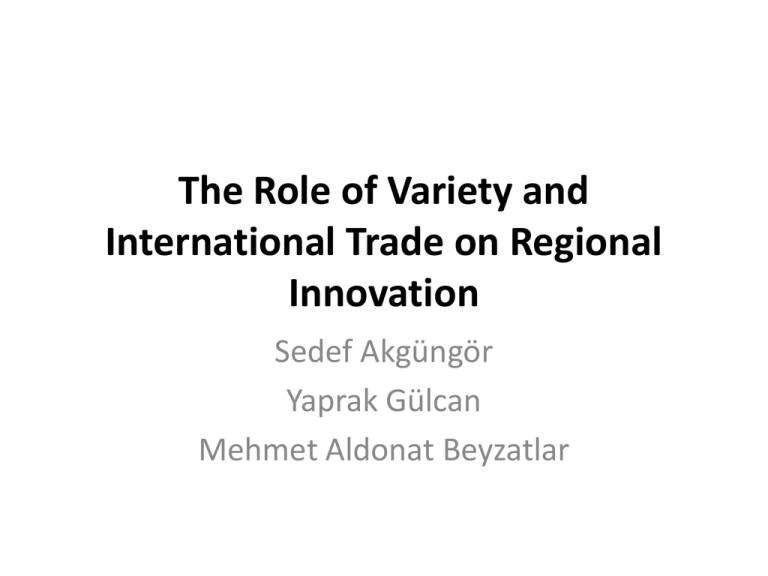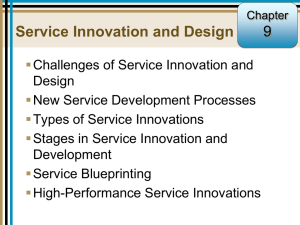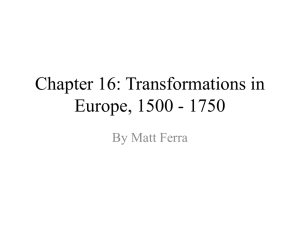Beyzatlar_2014
advertisement

The Role of Variety and International Trade on Regional Innovation Sedef Akgüngör Yaprak Gülcan Mehmet Aldonat Beyzatlar Outline • • • • • • 1. Introduction 2. Theoretical Background 3. Hypotheses 4.Econometric Model 5. Empirical Results 6. Conclusion and Policy Implications Introduction • Variety and international trade are two significant variables that explain regional innovativeness. • Innovation is a central process in driving economic growth through short run productivity gains and long run employment growth by creating new economic activities. • innovation draws on knowledge that is often sourced locally. • There is a wide and growing literature that treats innovations as an evolutionary branching process Variety-Innovations • Variety: the number of actors, activities and objects required to describe an economic system. • Related variety • Unrelated variety • Over the past decade, considerable number of academics examined the effect of related variety on regional growth by using different variables. • The studies found positive interaction between relatedness and growth in many case studies, such as Italy, the Netherlands, Spain, Turkey. Variety-Innovations • Related variety and unrelated variety are both significant in explaining regional innovations (Castaldi, Frenlen and Los, 2013). – Related variety enhances innovations as related technologies are more easily recombined into new technologies. – Unrelated variety enhances technological breakthroughs since radical innovations stem from previously unrelated technologies opening up whole new functionalities and applications. International Trade-Innovations • International trade theory highlights the importance of technological innovations in explaining the country’s international competitiveness (Fagerberg, 1997). • Schumpeter points out that economic development are a dynamic process that derives from industry and trace. • New products, new ideas play significant roles in international trade. • Marquees-Ramos and Martinez Zarzoso, 2010 point our the importance of technical achievement on export performance. • Atkesen and Burstein (2010) point out the strong tie between firms’ welfare, innovation and international trade. Long Term International Trade Ties and Innovations • The impact of international trade on innovation presents the question of whether the influence of long term trade relationships is higher that overall impact of international trade on innovation. • The case of Turkey and Germany presents an interesting case study here. • Turkey and Germany are two nations with various political, military, economic, social, cultural and historical ties along the years. The relationship between Turkey and Germany has gained momentum within the framework of “Contract Labor Migration” that was signed by Turkey and Germany in 1961. • Dense political, economic and cultural relations between Turkey and Germany and long term trading relationship influences innovation. • ????? Turkey-Germany Trade Ties • Germany is Turkey’s biggest trading partner in the EU. While the volume of trade between Turkey and the Germany was about 6 billion Euros in 1990, it has reached almost 24 billion Euros in 2009. • Germany, with more than 4.000 firms, is the biggest foreign investor in Turkey. Besides trade connections, the economic cooperation between two countries expands every day by various bilateral research and technology projects. Objectives of the Study • 1. Explore the impact of related variety and unrelated variety on regional innovations. • 2. Explore the impact of overall regional international trade on regional innovations • 3.Understand the impact of long-trade ties between two countries on regional innovativeness. Theoretical Background • The theory follows the idea that international trade is not only trade of goods and services but it consists of movement of ideas and innovations. • Spulber (2008) presents a model where he contends that without international trade in technology, the country’s human capital is equal to population multiplied by base productivity. • When international trade occurs, the human capital increases by the amount of technology. • The model developed by Spulber (2010) show that innovation and international trade together play an important role in domestic markets where technology trade increases product variety and increases national income in each country and increases total gains from trade. • Similar idea has also presented by different scholars where the idea is that technological innovations and international trade go parallel in regions and countries (Egger and Keuschnigg, 2011; Damijan and Kostevc, 2010). • The concept of recumbinant innovation contends that related variety and unrelated variety enhances innovations in two distinct ways. • Recumbinant innovation vs. branching innovation • Branching innovations refer to technological improvements along a particular path • Recumbinant innovations refer to fusions of multiple paths. • Recumbinant innovations create short cuts (facilitate learning and knowledge exchange) allowing agents to escape from technological lock in.. Hypotheses • The theory on innovations and trade and the theory on recombinant innovations leads to the following three hypotheses: • Hypothesis 1: There is a positive relationship between i nternational trade and regional innovativeness • Hypothesis 2: The impact of international trade on regi onal innovativeness increases when international trade ties are between the partner countries is higher than a verage. • Hypothesis 3: There is a positive relationship between related variety and regional innovativeness. Data • Dependent variable: Innovations – Patent data – Turkish Patent Institute (TPE) for the period 20022011 at the NUTS3 level for 81 provinces of Turkey. – Patents and utility models are used as the proxy for innovation • Independent variables • • • • 1. Variety Related and unrelated Entropy measures The main advantage of the entropy measure, and the reason for its use in the context of diversification, is that entropy can be decomposed at each sectoral digit level. • Entropy measures are computed using export data, which is available for Turkey at the four-digit level from the Turkish Statistical Institute (TUIK) database. • 2. Export • Export data of 81 regions for the 2002-2011 • Data were collected at the NUTS 3 level as the spatial unit of analysis to deal with detailed export map of all 81 provinces for the period 2002-2011. • Related Variety • Unrelated Variety • Weighted sum of the entropy at the four digit level within each two digit level. • Entropy of two digit distribution. • Let all four digit sectors i fall exclusively under a two digit sector Sg where g=1,…….,G • Derive two digit shares Pg by summing the four digit shares Pi Unrelated Variety Related Variety where • The concept of entropy measures implies that four-digit entropy is equal to the sum of two-digit entropy as unrelated variety and the weighted sum of four-digit entropy within each two-digit class as related variety. • Related variety is considered to be the indicator for Jacobs’s externalities because it measures the variety within each of two-digit classes. • By contrast, unrelated variety measures the extent to which a region is diversified in very different types of activity. Econometric Model Independent variables: • total international trade volume (TINT), • trade volume with Germany (TG), • related variety (RV) • unrelated variety (UV) Dependent variable: Patent and utility model applications (P) The period of analysis is 2002-2011 for 81 provinces of Turkey. All variables used in panel-data analysis are handled in natural logarithm form and stationary condition. Model 2SLS Panel Regression Results Dependent Variable is P Model 1 Model 2 Constant -9,541*** -4,257*** RV 0,238*** 0,351*** UV 0,236** 0,227* TINT 0,620*** TG DW F-stat 0,415*** 0,425 0,368 1,251 1,103 154,737*** 121,802*** Conclusion • This study confirms the hypotheses that there is a positive relationship between – (i) related variety and innovation, – (ii) trade and innovation. • The study also confirms that there is a simultaneous relationship between patent applications and international trade. • The study found no evidence that trade ties with Germany has a stronger influence on patent applications than overall international trade. • More research is needed to explore the impact of international trade with Germany on innovativeness. • A closer examination of sectoral distribution of trade with Germany and sectoral patent applications might give a different result.









